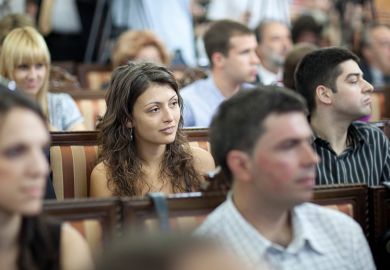It is commonly said of young children that they learn most through handling things and through play. In my experience, this is equally true of adults.
I first witnessed this while teaching at the Centre for Alternative Technology’s Graduate School of the Environment in mid-Wales. Founded in the early 2000s, the school met high academic standards, but was free to innovate in pedagogical methods.
For instance, small groups were given practical tasks to solve in a designated outside area full of assorted materials, which was sometimes known as “the playground”. The students could ask for tools, advice and extra enabling items, such as rope or nails.
It was very clear that these sessions produced a great surge of energy and enthusiasm that flowed back into the classroom. And, of course, it created vigorous interpersonal bonding. Such haptic and ludic experiences have many of the same qualities of a classic field trip, but field trips have become quite rare on account of expense, paperwork and legislation.
I think all universities should have their own playgrounds. There should be some shelter: the architecture and engineering students could build the first roof. Then the structure could be endlessly extended, demolished, rebuilt – all with hand tools, of course. It would become an informal campus focus. There could be fires, barbecues, demonstrations, open-air debates.
Of course, students are there for a serious purpose, and should log their experiences, take measurements, do calculations. But there is power in combining heads and hands, work and play, in the open air.
Hands-on learning should not end there, however. A modern campus is like a small town, with everything a small town needs and produces, and a few more things besides. It is more or less a microcosm of the universe, right there on the doorstep of the lecture theatre, ideal for bringing teaching to life, especially in science, technology, engineering and mathematics.
I first explored this idea at the University of Bath through contact with the estates department. All universities have these, and rely on them to keep the vast machine running. They deal with heating, lighting, electricity, ducting, building maintenance, water supply, waste water, solid waste and grounds maintenance. All these are sources of real data from real-time processes. But estates departments don’t do any teaching and are considered to exist in a separate universe. This marks a serious failure to recognise the opportunities.
Bath is blessed with an outstanding energy and environment manager, Pete Phelps, who has managed to keep its carbon emissions pretty well flat while the size of the university has doubled. This is an amazing achievement. Pete takes my natural sciences students on to roofs to see the photovoltaic panels, and down to the “engine room”, where a combined heat and power plant generates electricity from gas, and hot water from the waste heat. The students are notionally energy-literate, but this allows them to see what it actually means to convert energy from one form to another, at scale.
Walking through the belly of the beast, students are able to “read” the infrastructure: the colours of different pipes carrying gas, heat, clean and waste water, cables carrying different voltages of electricity, manhole covers for different services, and the invisible skeins of service runs between them. We have followed the flow of water manhole by manhole from where it comes in to where it leaves the campus.
Pete also has the statistics on energy costs and water consumption across the campus. These make perfect material for coursework and exam questions that test students’ fundamental understanding of energy processes.
The estates department also deals with waste, of course, and students are able to observe the operation of the so-called “waste hierarchy”, from extended product life through various levels of recycling to final disposal. They see the sorting in progress, and get a chance to rummage in the scrapyard, where abandoned electronic equipment is organised for refurbishment and shipping off to schools in Africa. Of course, this changes their attitudes to waste – and their behaviour. When the waste hierarchy turns up in the exams, they have a visceral feel for its meaning.
Many universities also have semi-natural areas with trees. These are fantastic resources over and above their potential as locations for academic playgrounds. Surprisingly, some students have never previously encountered nature even in this attenuated form, and their first exposure to it is a profound if not particularly pleasant experience.
Moreover, there is no end to the unexpected conclusions that you can induce students to draw from a visit to the woods with simple measuring equipment. You can distinguish about 50 different species within half an hour – but they are nearly all plants. This brings home to students that however much animals may monopolise television nature documentaries, they account for only 1 per cent of biomass. And of those animals observed, none will be mammals. But isn’t this “the Age of Mammals”? Nope.
Another observation is that you can’t eat any of this biomass. Food production requires a drastic industrial makeover of land cover: what are the implications for biodiversity? And what if you need those trees to mop up excess carbon dioxide?
How many trees would it take to make the university carbon-neutral? How many would you need to provide heating for the whole campus? And how many would you save from being turned into dreary textbooks if universities were to stop wasting the teaching resources on their doorsteps?
Peter Harper is an independent environmentalist and visiting lecturer in the department of natural sciences at the University of Bath.
POSTSCRIPT:
Print headline: A practically perfect playground
Register to continue
Why register?
- Registration is free and only takes a moment
- Once registered, you can read 3 articles a month
- Sign up for our newsletter
Subscribe
Or subscribe for unlimited access to:
- Unlimited access to news, views, insights & reviews
- Digital editions
- Digital access to THE’s university and college rankings analysis
Already registered or a current subscriber?








